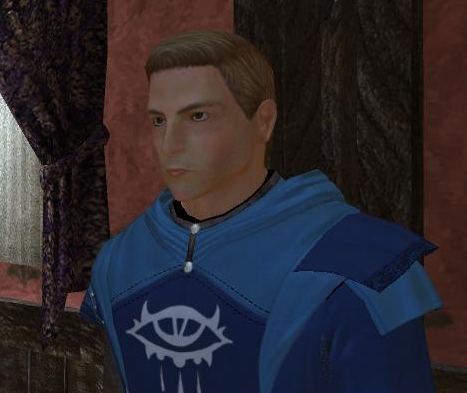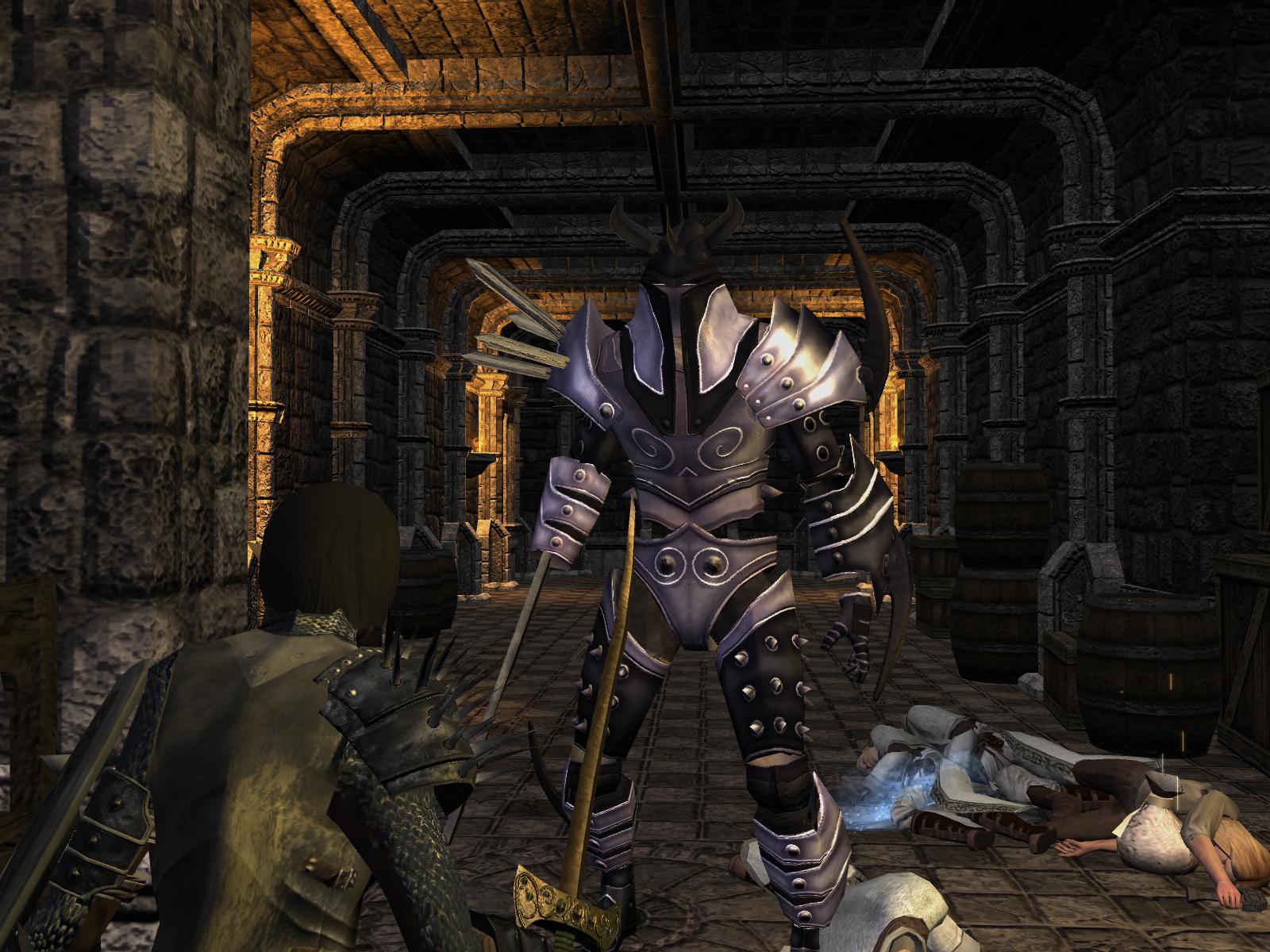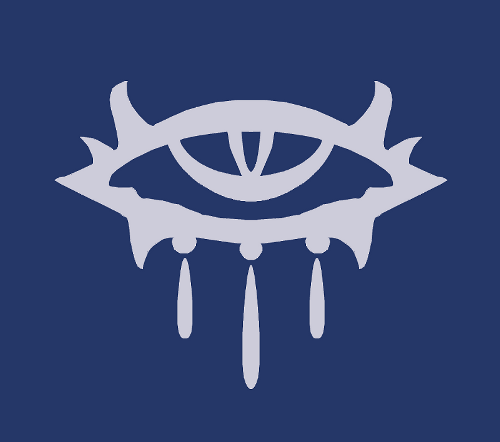I swear, I don’t know how it is that fate sees me writing up
reviews on so many sequels rather than the first entry into a game series. Dead Space 2, Fable III, Dragon Age II...I mean, by this
point, it’s almost a running joke – especially since I’ve reviewed NONE of the
predecessors of any of those three in particular. So, let’s chuck another onto the pile, shall
we?
Here’s Neverwinter
Nights 2, a game that runs on the 3.5 edition rules of Dungeons and Dragons
(more or less), made by Obsidian Entertainment and published by Atari. This is a fairly drastic change from the
previous game, which was developed by BioWare, and went by the Third Edition
Rule Set of D&D – again, more or less – a change that manifests itself in a
number of ways. And, for the record,
this will not be a review of any of the expansions that have come out for the
game (i.e. Mask of the Betrayer, Storm of
Zehir, etc.) mostly because I don’t have them and I haven’t played them
(and, y’know, fodder for the future as well).
Still, the game should be able to stand up on its own merits, after all…
I will say this for it, NN2
is actually very enjoyable all on its own, which is helped because the game
only vague refers to the events of the first one. You get some vague mentions of the Wailing
Death and of the war with Luskan – neither of which seems to have affected
Neverwinter that much, but we’ll get
to that – and then mentions the a War with the “King of Shadows” that oddly
wasn’t even mentioned in the previous game despite being some big event.
Seriously, I know that the switch between studios means
things got shuffled around, but c’mon guys! Continuity!
 |
| Did Nasher think the symbol of the genocidal lizard lady was just that awesome? |
Of course, you don’t actually start in the city of Neverwinter, but actually in the
never-before-mentioned village of West Harbor in the Mere of Dead Men (which is
an actual place in the Forgotten Realms
campaign setting, before you start laughing).
As a young man/woman in the care of an old elf ranger who is very Spock
in his ways, you enjoy a tutorial level of a quaint little village fair…which
is immediately juxtaposed when the Plot finds the village that night. After saving the place – sort of – your
foster father sends you into the swamps to dick around with some lizardmen and
find a magic shard of unknown origin, telling you to take it to the city of
Neverwinter.
Like pen and paper Dungeons & Dragons, you can choose
between several different races. These
include your usually vanilla D&D stock of humans, elves, dwarves,
half-elves, halfings, half-orcs, and gnomes; as well as several subraces for
the non-humans of all kinds, including the plane-touched – which are basically
humans that have either demon or celestial ancestry. Each race has its own pros and cons to
playing it. Top tip, if you’re just
starting out in the D&D world and have no idea what you’re doing – human
fighter is not a bad race/class
combination to go with. They are
generally the first one’s hit by newbies in pen and paper D&D and are about
the easiest to play.
 |
| Behold and be transfixed by the variety! |
Which brings us to classes.
Now, while the expansions add more base classes, NN2 only gives the basic allotment of Barbarian, Bard, Cleric,
Druid, Fighter, Monk, Paladin, Ranger, Rogue, Sorcerer, Wizard, and
Warlock…wait, what? Yes, apparently, the game decided to throw in
another basic character class that isn’t in the Player’s Handbook for 3.5
Edition. Now, I’ve never played a
Warlock in actual pen and paper D&D (mainly because I’ve never even seen a copy of “The Complete Arcane”), but as far as NN2 goes…they’re nothing to write home about. Sure, they don’t have the limitations that
wizards and clerics do about preparing spells and don’t have the limited number
of spells that sorcerers and bards do, but they are easily outclassed by pretty
much anyone else of an equal level.
I’m sure if you stat them out appropriately, they become
pretty powerful, but who has the time to micromanage?
There’s also a variety of tasty Prestige classes, some of
which are very easily gotten to (a fighter or barbarian can qualify for
Frenzied Berserker almost right off the bat) and some not so much (5 ranks of Survival to play a HARPER AGENT?! THAT’S NOT EVEN A BARD
SKILL!!!!). But, as with the races, the
classes all provide their own flavor and variety of pros and cons.
Not to be dissuaded by this, when I first played I had taken
my own advice (after starting up a sorcerer and failing miserably far too often
for my own enjoyment) and had started up a human fighter. Thus, it only seemed fitting to bring back to
life my noble warrior of Chaotic Good ali – oh, did I not mention alignments? In
Dungeons & Dragons, for the uninitiated, you have alignments that determine
how much of a goodie-good or how much of a complete asshole your character
is.
However, generally, PCs tend to be within the good or neutral alignments.
Generally.
However, don’t pay too much mind to it, as it has next to no
real impact on the game besides either people being utterly terrified of
you/singing your praises and either giving you or not giving you things that
you want or need. I will say that
chucking a few Skill points into your Diplomacy, Bluff, and Intimidate skills
would not be bad regardless of whatever class you pick, as all of them are
immensely useful in dialogue. It’s
actually really hilarious and I would almost recommend picking Chaotic Evil and
picking every dialogue option that makes you out to be a supremely evil,
uncaring jackass. It’s hilarious,
especially later on when the game has to contrive a way to keep the plot going.
Anyway, as I said, my noble warrior with aspirations of
knighthood once more came back into being.
He felt a bit incomplete, however, so I made the logical opposite – a
Lawful Evil Tiefling Wizard/Pale Master.
In their parallel universes, the two set off on their journeys and its
gone pretty well so far, so who am I to complain?
One might notice I haven’t gone too much into the actual
gameplay mechanics and have instead talked for about seven paragraphs on just
what has been adapted from the pen and paper D&D. That’s mostly because…well, there’s not much
to talk about. If you’re a fighter, you
click on a target and you’ll hit them repeatedly until they die. Unless you’re playing a spellcaster class,
combat becomes very quickly uninvolving, something that the first game also
suffered from. You select your target and watch your character charge forth to
deal out the pain, yawn-o-rama.
 |
| "Sarah Connor?" |
Now, when you’re playing a spellcaster class – such as my
wizard – the combat becomes…slightly
more involving. A neat little trick is
that you can pause the game, survey the battlefield, and act accordingly. However, there’s really no strategy involved. Again, select target and wail on them until
they die – necking health potions as needed.
That works for both melee and ranged attacks, oddly enough. The pause feature is useful, too, for mages
as it allows you to work out where best to cast your summon fiery apocalypse spell (okay, that’s not what it’s called,
but it’s close to that).
But that’s so far as combat goes. Other characters in your
party are controlled by the A.I., which you can set on your own – with
sometimes hilarious results – and you can have up to three other people at a
time without cheating. Throughout Act
II, you’ll get an additional member of the group, but apart from that you’ll be
pretty much stuck with your three (again, unless you cheat). Like any good D&D party, it’s best to
have a well-balanced group. Let’s say, a
fighter, a mage, a cleric, and a rogue, or some variation thereupon. Like any actual
D&D party, you probably are going to have many situations where that won’t
be the case. Including some companion
quests where you’ll be required to have one of them tag along and they’ll force
their way into one of the party slots.
As for the characters who serve as your companions
(replacing the apparently derogatory term ‘henchmen’ from the first NN), they all have their own
personalities and backstories of one sort or another. Some of them were cut
from the game for the sake of time, but several remain and a lot of them are
worth getting into (like Khelgar’s) or are gotten through during the actual
plot unless you’re just a complete dick (like Elanee’s). They range from the psychotic to the bizarre,
from the noblest of good to the most baby strangling varieties of evil, and
it’s up to you to arrange and equip them as you see fit.
 |
| Seriously, Nasher, why did you pick this as your symbol? She tried to flash fry you all! |
Which brings me to what is really my only gripe about the
inventory system – why does everything
take up the same amount of space?
You have four “pockets” in your pack, each of which can carry a
multitude of items in slots. My question
is why does a shard of metal that’s barely bigger than my thumb take up the
same amount of space as my greatsword of
mass evisceration +7? This isn’t
like in the first game, when you actually had to do a fair amount of inventory
Tetris to get your items to fit if you started picking up every little thing.
Oh, and there’s an influence system with companions too that
I had forgotten to mention. It’s
basically in having to play within their alignments (which will almost
assuredly have you lose influence
with other members of your party of opposing alignments unless you have all of
one type) with quest decisions and other choices to assure that they won’t turn
on you in the final battle against the King of Shadows.
Which brings me to the actual storyline. Like any really well-crafted D&D campaign,
it has layers and layers of complexity and several different plotlines running
together and apart all at once. The player
gets involved after the attack on West Harbor, getting a shard of a Githyanki
silver sword that was once used to defeat the King of Shadows. However, the Githyanki were heading the
attack on the village because they want the sword back. In the meantime, it is learned that Black
Garius – a mage in Luskan – is gathering together several Shadows Priests,
servants of the King of Shadows. It’s
revealed that the King of Shadows wasn’t defeated at the battle at West Harbor,
but was only delayed in his return. And
on top of all this, the players has
to contend with the crazed warlock Ammon Jerro, who was the one to defeat the
King of Shadows before, trying to recover all the shards of the Silver Sword
before they can.
And that’s just Act
One.
When I say it takes up the length of a whole campaign, I can
honestly say that it does. I definitely
enjoy the story and seeing how Neverwinter and the lands surrounding it have
developed after the first NN game
(though I’m wondering why Lord Nasher’s chief knights are using the symbol of
Morag as their own now). I’m not big on
the combat, though the interface is about as simplistic as you can get, with
handy quick slots allowing you to bookmark specific items, spells, and even
skills and feats for use at literally the click of a button (and, as the game
reminds you, there are 120 per character so don’t be stingy!).
The combat can drag on for a while, especially later on in
the game against opponents with ludicrously high Armor Class and taking damage
like you’re attacking them with a rusty spoon instead of a Sword of Complete and Utter Kick-Ass +5. But, and this is nothing against the game
really, but it lacks the vital component of D&D that’s just sitting down
with a bunch of your friends and cracking jokes and kicking butt. But, of course, if you get this game then that
isn’t what you come to it for. As a
single player RPG, it’s great.
Stylistically different from its predecessor, Neverwinter Nights 2 shines brightly as a gem of the genre. My gripes about the combat and the inventory aside, I say give it a whirl if you're a fan.
Neverwinter Nights 2
is available for PC from Obsidian and Atari.

No comments:
Post a Comment